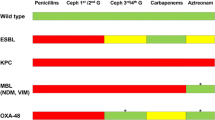Abstract
The tolerability of the 2 most frequently used carbapenems, imipenem/cilastatin and meropenem, is reviewed. Both of these drugs, but especially imipenem, are potentially neurotoxic and may cause seizures if overdosed relative to renal function and/or bodyweight. The therapeutic margin is considerably narrower with imipenem/cilastatin which cannot be given at doses required for treatment of bacterial meningitis. Meropenem on the other hand, is considerably less prone to cause seizures and its tolerability and efficacy are well documented in 3 relatively large, controlled studies in adults and children with meningitis. They showed that meropenem was as effective and well tolerated as cefotaxime or ceftriaxone. Another potential advantage of meropenem over imipenem/cilastatin is that it can be given intravenously at a high rate without increased risk of nausea or vomiting. An obvious reason for using a carbapenem instead of a cefalosporin for empirical treatment of life-threatening infections is that both imipenem/cilastatin and meropenem have a broader spectrum of activity. They are also more resistant to hydrolysis by the most common β-lactamases, including the class I cephalosporinase frequently produced by Enterobacter spp. and Pseudomonas spp. and the extended spectrum enzymes, now commonly found in Escherichia coli and Klebsiella spp.

Similar content being viewed by others
References
Sader HS, Jones RN, Gales AC, et al. Antimicrobial susceptibility patterns for pathogens isolated from patients in Latin American medical centers with a diagnosis of pneumonia: analysis of results from the SENTRY Antimicrobial Surveillance Program 1997 (SENTRYLatin America Study Group). Diagn Microbiol Infect Dis 1998; 32: 289–301
Blondeau JM, Yashuk Y, Suter M, et al. In-vitro susceptibility of 1982 respiratory tract pathogens and 1921 urinary tract pathogens against 19 antimicrobial agents: a Canadian multicentre study (Canadian Antimicrobial Study Group). J Antimicrob Chemother 1999; 43 Suppl. A: 3–23
Jones ME, Thornsberry C, Livermoore DM, et al. Prevalence of Acinetobacter spp. isolates with reduced susceptibility to imipenem, as determined by a USA-wide electronic surveillance network. J Antimicrob Chemother 1999; 43: 429–31
Calandra GB, Wang C, Aziz M, et al. The safety profile of imipenem/cilastatin: worldwide clinical experience based on 3470 patients. J Antimicrob Chemother 1986; 18 Suppl. E: 193–202
Norrby SR, Newell PA, Faulkner KL, et al. Safety profile of meropenem: international clinical experience based on the first 3125 patients treated with meropenem. J Antimicrob Chemother 1995; 36 Suppl. A: 207–23
Kahan FM, Kropp H, Sundelof JG, et al. Thienamycin: development of imipenem-cilastatin. J Antimicrob Chemother 1983; 12 Suppl. D: 1–35
Norrby SR. Imipenem/cilastatin: rationale for a fixed combination. Rev Infect Dis 1985; 7 Suppl.: S477–81
Calandra G, Lydick E, Carrigan J, et al. Factors predisposing to seizures in seriously ill infected patients receiving antibiotics: experience with imipenem/cilastatin. Am J Intern Med 1988; 84: 911–8
Norrby SR. Neurotoxicity of carbapenem antibiotics. Drug Saf 1996; 15: 87–90
Hikida M, Musakawa Y, Nishiki K, et al. Low neurotoxicity of LCJ 10,627, a novel 1-beta-methyl carbapenem antibiotic; inhibition of gamma-amminobutyric acid A, benzodiazepine, and glycine receptor binding in relation to lack of central nervous system toxicity in rats. Antimicrobial Agents Chemother 1993; 37: 199–202
Schliamser S, Bolander H, Kourtopoulos H, et al. Neurotoxicity of benzylpenicillin: correlation to concentrations in serum, cerebrospinal fluid and brain tissue fluid in rabbits. J Antimicrob Chemother 1988; 21: 365–72
Schliamser SE, Broholm KA, Norrby SR. Comparative neurotoxicity of benzylpenicillin, imipenem/cilastatin and FCE 22101, a new injectible penem. J Antimicrob Chemother 1988; 22: 687–96
Wong VK, Wright Jr HT, Ross LA, et al. Imipenem/cilastatin treatment of bacterial meningitis in children. Pediatr Infect Dis J 1991; 10: 122–5
Schmutzhard E, Williams KJ, Vukmirovits G, et al. A randomised comparison of meropenem with cefotaxime or ceftriaxone for the treatment of bacterial meningitisin adults. J Antimicrob Chemother 1995; 36 Suppl. A: 85-97
Klugman KP, Dagan R, Meropenem Meningitis Study Group. Randomized comparison of meropenem with cefotaxime for treatment of bacterial meningitis. Antimicrob Agents Chemother 1995; 39: 1140–6
Odio CM, Puig JR, Feris JM, et al. Prospective, randomized, investigator-blinded study if the efficacy and safety of meropenem vs. cefotaxime therapy in bacterial meningitis in children. Pediatr Infect Dis J 1999; 18: 581–90
Norrby SR, Gildon KM. Safety profile of meropenem: a review of nearly 5000 patients treated with meropenem. Scand J Infect Dis 1999; 31: 3–11
Fink MP, Snydman DR, Niederman MS, et al. Treatment of severe pneumonia in hospitalized patients: results of a multicenter, randomized, double-blind trial comparing intravenous ciprofloxacin with imipenem/cilastatin (The Severe Pneumonia Study Group). Antimicrob Agents Chemother 1994; 38: 547–57
Eklund AE, Nord CE. A randomized multicenter trial of piperacillin/tazobactam versus imipenem/cilastatin in the treatment of severe intra-abdominal infections (Swedish Study Group). J Antimicrob Chemother 1993; 31 Suppl. A: 79-85
Author information
Authors and Affiliations
Corresponding author
Rights and permissions
About this article
Cite this article
Norrby, S.R. Carbapenems in Serious Infections. Drug-Safety 22, 191–194 (2000). https://doi.org/10.2165/00002018-200022030-00003
Published:
Issue Date:
DOI: https://doi.org/10.2165/00002018-200022030-00003




